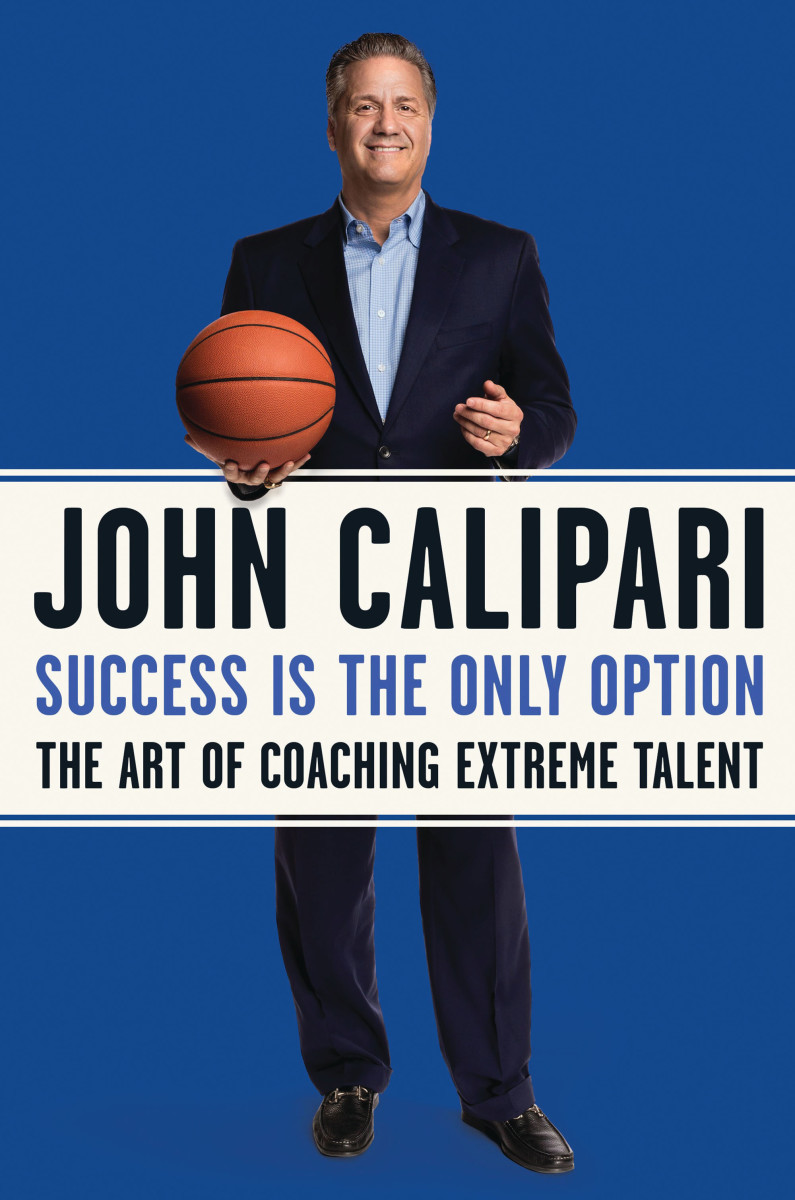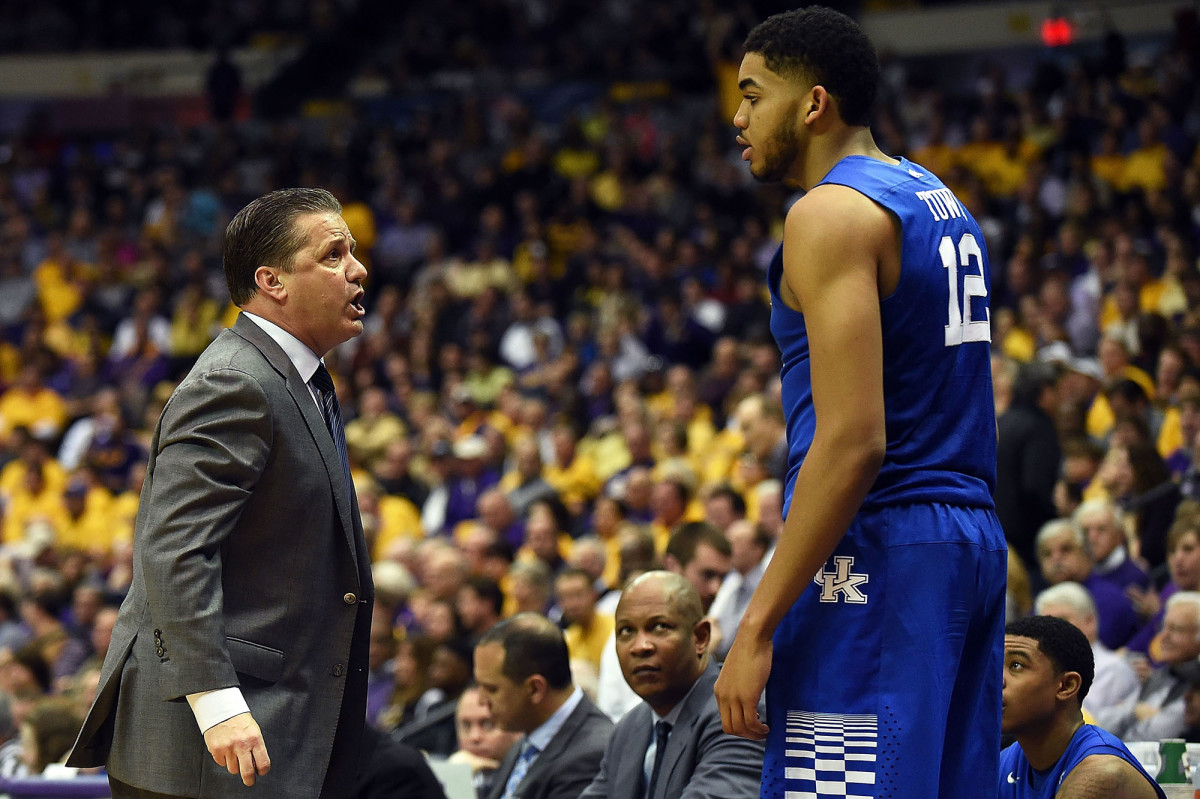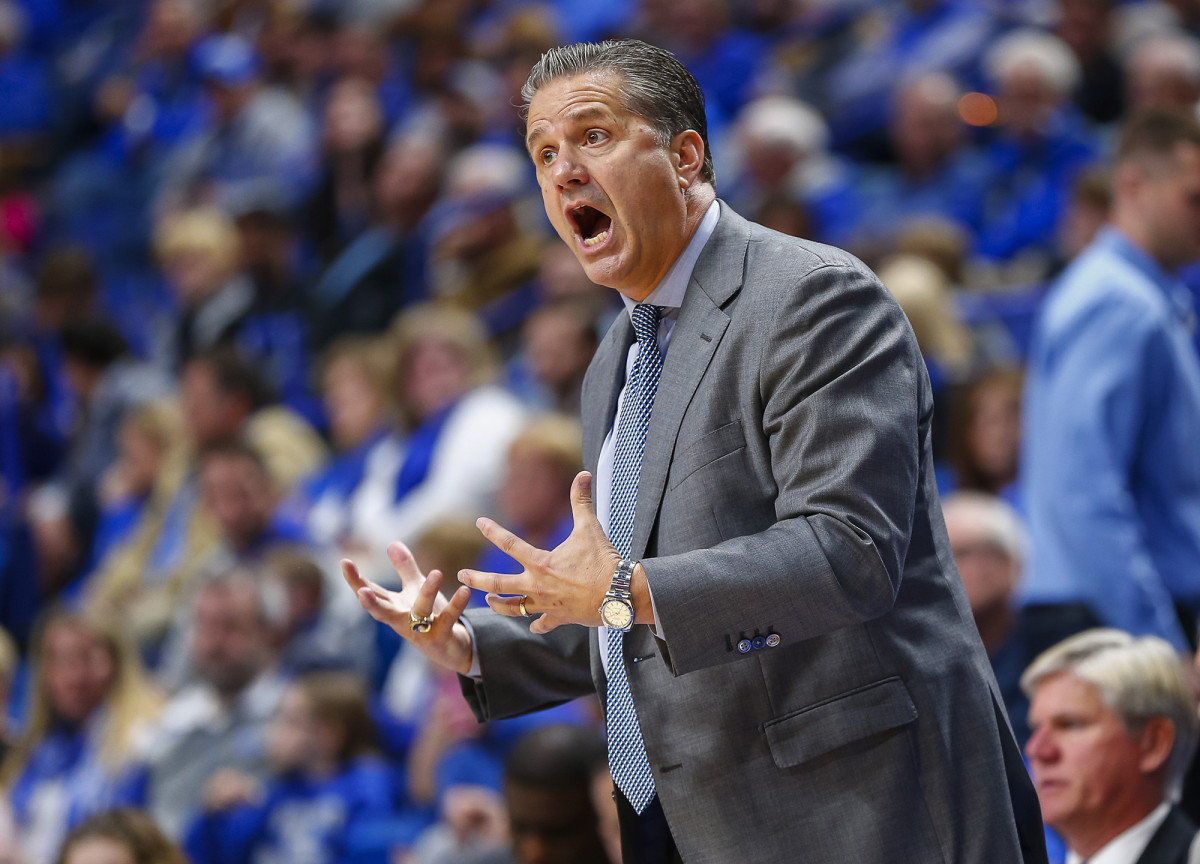How John Calipari helped Karl-Anthony Towns ditch 'nice guy' persona on the court

The following is excerpted from Success is the Only Option by John Calipari. Copyright © 2016 by John Calipari. Used by permission of HarperCollins. All rights reserved.
My job is to push each of these players through his comfort zone.
In the weight room, you’ll hear, “No pain, no gain.” I must make each of them as uncomfortable as I can in practice daily and in individual workouts, stretching them to the limit so they discover what their limit really is.

Success is the Only Option
by John Calipari
Kentucky’s coach shares his secrets on the art of coaching extreme talent and the keys to winning, on and off the court.
Karl-Anthony Towns was seven feet tall by the time he came to us in 2015 for his freshman season. He was not quite as explosive an athlete as Anthony Davis, who is just an inch or two shorter, but he had other attributes. Karl moves his feet very well and has long arms, soft hands, and elite hand-eye coordination. He had been a baseball pitcher and also played a bit of golf, and if you watched his comfort level at handling the basketball—shooting it, passing, dribbling—you could imagine him doing those other things. There is a natural grace about him that you don’t see in many athletes his size. (Just so you know, Karl played in our celebrity softball game for charity this past summer and hit a slow-pitch softball out of a minor league ballpark.)
Off the court, he has the same ease about him, a comfort in his own skin. He was elected class president at his high school in northern New Jersey, and he’s the type who could have been chosen “most likely to succeed” even without being a basketball player. His high school grade point average was over 4.0, when weighted for his honors classes, and he talked of becoming a doctor, as he put it, “after the basketball goes flat.” He came to Kentucky because he liked the kinesiology program, which was his major and what he plans to continue studying as he finishes his degree.
His father, a high school basketball coach, drilled Karl in fundamentals. There were weeks that he only let him use his left hand to shoot, so he could be an offensive threat going in either direction. Karl’s mother is a native of the Dominican Republic, and I first spent time around him when he was sixteen years old and I was coaching the Dominican national team. He was in ninth grade and 6'10". His teammates were professional players either in the NBA, like Atlanta Hawks all-star center Al Horford, or in various international leagues.
Karl’s talent was obvious but he liked to roam around the perimeter, near the three-point line, rather than going down low and mixing it up with the big guys. In high school games, he attempted a ton of three-point shots and hit for a decent percentage. When he got to Kentucky, that was still his inclination. The finesse game. It was pretty to watch and it would have helped us plenty; after all, players who can shoot the ball from distance are always welcome.

But I wouldn’t accept it. We said, “You’re going to get in the post you’re going to learn to battle.” There have been big players in the NBA, 6'10" and up, who are good outside shooters but shy away from the physicality down low. They never amount to as much as they could. And then there are guys like Kevin Garnett and Karl Malone, excellent jump shooters who were also skilled and relentless around the hoop. Even Dirk Nowitzki, a seven-footer and one of the best three-point shooters in NBA history, has terrific post moves. If the other team tries to defend him with a smaller player, in order to chase him off the three-point line, Dirk posts him up down low and scores that way. He’s got sharp elbows and a tough mind-set.
Malone is in the Hall of Fame and Garnett and Nowitzki will join him the moment they’re eligible. That’s the future I envisioned for Karl, but I knew I had him at a formative moment. A window can close on young players. The danger is that they will achieve what may feel like a high level of success without ever having to reach down and develop all aspects of their games. They might even become all-stars, but they’ll never be Hall of Famers or centerpieces on a championship team.
An 18-year-old like Karl cannot be expected to grasp the full dimensions of his potential, so I function like an early warning system: Here’s what I see inside you. And here is how not to let it go to waste. It’s not that I have a greater ambition for a player; I just may have a better road map.
Expert Predictions: SI writers make picks for Final Four, Player of the Year, more
The key for all of them is to build from strengths while also developing new parts of their games. I don’t want them to try things in games they are not capable of, but once they’ve developed some proficiency, you can’t be scared to do it in a game.
Each summer I tell them, “Each of you should figure out ways to make yourself a little uncomfortable. Work on different parts of your game in pickup games. In other words, in some games you’re looking for drives, in other games you’re looking for jumpers. Some games you’re looking to post up, other games you’re looking for pick-and-pops. Some games you’re not going to shoot any balls because you’re going to be concentrating on creating for your teammates. Challenge yourself with one-dribble pull-ups or pull-ups in transition. If you’re not uncomfortable, you’re probably not improving.”
I let Karl know from day one that I wanted him to get down on “the block”—the area just outside the three-second lane, close to the basket. He would have to learn how to establish position, make himself available to properly receive a pass, and operate with his back to the basket. Proper footwork would get him a short jump hook, sometimes a dunk. He’d be in position to get offensive rebounds.

An oddity of basketball is that you want to have tall players, but they must “play low” with their butts down and their feet spread wide. The competition down on the block isn’t glamorous. You bang with your opponent. He drips sweat all over you. At the end of the game you’ve got bruises—or sometimes even stitches if you catch a stray elbow. It’s a dogfight every night, and just to survive, you’ve got to get in the weight room and toughen up.
I mentioned that the modern style of basketball is now more wide-open, with shooters spread out all over the floor. In some ways, that makes a player like Karl even more valuable. If he’s a threat down low, he’ll find less “traffic”—fewer big bodies—to contend with. Because he already had advanced court vision and passing ability, he could find open teammates when he was double-teamed, but no one would need to put two defenders on him unless he showed fight near the basket.
Karl was invested in being a nice guy. Great, I’d tell him. I love being around you. Everybody does, and hold on to that. But it can’t be your persona on the court. I’m never going to accept anything less from you and just shrug it off and say, “Oh, that’s just Karl being Karl.”
Playing low on every trip up and down the court is physically demanding, and he wasn’t ready for it. His legs and core weren’t strong enough at first to hold his position. To compensate, he resorted to using his upper body and elbows to move opponents and clear space for himself, and there were games early on in which he spent a lot of time on the bench with me because he got whistled for early fouls. Other times I had to sit him down because he wasn’t fighting. He would get pushed off the block or he just drifted off on his own, back to where he was comfortable, and looked for jump shots.
Ranking every team in college basketball from Florida A&M (351) to Duke (1)
That 2014–15 season was one in which we were absolutely stacked with talent. We platooned two five-man squads until we lost Alex Poythress for the season with a knee injury, but even after that we played nine and sometimes ten guys. We were bigger than most NBA teams, with two other seven-footers—Dakari Johnson and Willie Cauley-Stein. In most games, we could survive without Karl for stretches if we needed to.
A game at South Carolina sticks out in my mind as a turning point for Karl. It was mid-January, so not all that early in the season, but he was still catching on to how we wanted him to play. That’s normal; it always takes time. I’d see flashes of what I wanted, then he would revert. He made two of his three shot attempts that night, missed both his foul shots, and grabbed a grand total of one rebound.
I never leave a player on the bench as punishment, but it’s only fair to keep the kids out there who are doing more. Our platoon system only guaranteed minutes to players who were battling. He played just twelve minutes that night.
After the game, I saw Karl’s parents. He probably had rarely struggled much at anything before, and I knew it wasn’t easy for them to watch. I normally try not to talk to parents about basketball (I’ll engage them on almost anything else about their child) but I made an exception. “I’m not letting up,” I told them. “He’s going to be unbelievable by the end, but I’m not letting up on him.”
His mother said she thought he was fighting better in the post. “No, no, no,” I said. “He’s not battling enough. You want him to shoot threes? Nope, sorry, I’m not letting him go out there.” I then hugged her and kissed her cheek.

I was forcing Karl to do stuff that was uncomfortable. It wasn’t that he didn’t want to, but his body and mind were not habituated to that level of intensity. He was such a big kid and fluid athlete that in the past there was no place he wanted to get to on the court that anyone could keep him from, nothing he wanted to get done that anybody could really prevent. He could score inside or outside, whichever mood struck him. His coaches were always delighted.
It wasn’t just post play he had to learn. On defense, I was teaching him to guard pick and rolls, the most difficult skill—and increasingly, one of the most important skills—for any big man. With the professional game more wide open, and shooters spread all over the court, a big player has to be able to compete around the hoop and jump out on smaller players to either prevent open three-point shots or impede them if they try to drive to the hoop. Our team needed Karl to learn that and Karl needed it for his future.
I mentioned that our seasons are short and we have to make fast progress. Sometimes Karl didn’t seem to realize that. He could be almost too thoughtful for his own good, like he was dreaming up reasons to take baby steps. He told a reporter during the season, “It’s almost scientific. When you try to make something grow quicker than it’s supposed to grow, it doesn’t come out right. It’s not as good. ”
Really? That was news to me. One thing that really helps is that my former players often come back to campus during the summers and work out with our current ones. They get to know each other and continue to text and talk. Around midseason, Anthony Davis, on a day off for the New Orleans Pelicans, came around to visit. He had a sit-down with Karl and basically told him, “Hey, kid, you’d better step on the gas here.”
Jayhawks' Mason makes play of night as Kansas, Kentucky win at Champions Classic
Anthony had been through the same process. In the beginning, everyone said, “He’s talented, but wow, if he was only tougher and had a post game. What would that look like?”
Anthony had grown late in high school. He had guard skills, which was good, but I didn’t want him to have a guard’s mentality. He wasn’t resistant, and neither was Karl, really, but they needed to get stronger and get down low and see the benefits. Ultimately, it’s about experiencing some success. You want them to feel that, build on it, and then own it. After that, it becomes not what I want for them but, instead, part of their competitive identity. They embrace it as their own.
I believe in stating our intentions publicly. Say them out loud, and hold a player accountable for what you believe he can achieve. If that equates to pressure, it should be a good kind of pressure. I told the media (echoing what I had been telling Karl privately) that by the end of the season, I thought Karl would be the best player in college basketball. If he chose to leave us and enter the NBA draft, which I knew was likely, I wanted him to be the first overall pick.
That may have sounded unrealistic to some people. There was another player who everybody thought had the first pick locked up. And Karl was playing only about twenty minutes a game for us because of the platoon system, and sometimes less because of fouls. He was still learning—but he had stepped it up and was catching on fast.
